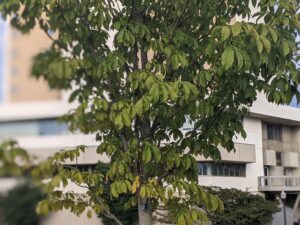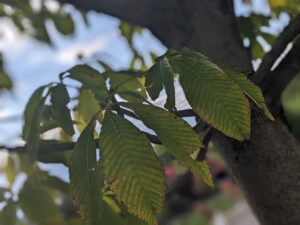A brief aside on Tree (Plant) Blindness:
As stated on my personal introduction, the media that got me interested in botany to begin with was the In Defense of Plants Podcast. One of the main goals as is stated each episode, is to cure the world of plant blindness one listener at a time. After listening to my first episode I immediately understood the term. I was doing yardwork while listening once and realized that I couldn’t even name the trees I was cleaning up after, let alone any details about their anatomy or history. At that point I had already decided I wanted to study ecosystem restoration and realized if I couldn’t name any trees, why would someone who didn’t already care about the environment be able to. And if neither I nor the environmentally apathetic cared, then how would restoration ecologists convince anyone to pay them to get work done? And thus began my incredibly slow journey to opening my eyes to not just the world of trees, but also the world of plants, bugs, fish, animals, and everything in between.
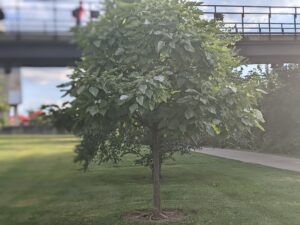
Common Name: Northern Catalpa
Scientific Name: Catalpa speciosa
One of my personal favorites is the Catalpa. This is one of the most recognizable trees when driving in my opinion, as the giant, entire, heart-shaped leaves are incredibly noticeable, and can be further confirmed by the long green fruits that resemble green beans to me. As the Peterson Field Guide for Trees & Shrubs describes it, these leaves can be opposite or in whorls of 3, and has a distinct odor when leaves are crushed. The leaves also come to a longer point when compared to the common / Southern Catalpa
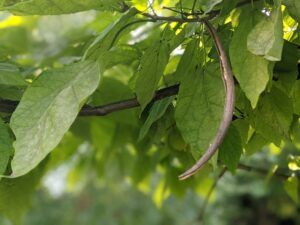
A close of up one of the distinctive “green bean” fruits

A close up on the large heart-shaped leaves. Many of these leaves are bigger than my head.
This particularly tree and several nearby appeared to be suffering from some sort of blight, but leaves are typically a bright to dark green and vary in size. This catalpa was seen along the Olentangy River Trail, and was surrounded by grass on all sides. While the general location may be along the river, this tree was merely along a wide lawn area.
The Morton Arboretum describes this trees white flowers as fragrant, the tree itself as adaptable, but notes that the wood is particularly weak.
Common Name: Yellow Buckeye / Sweet Buckeye
Scientific Name: Aesculus flava
What a classic tree. While it might not be THE Ohio Buckeye, I think this tree is equally as deserving of recognition for not stinking. This tree has oppositely arranged, palmately compound leaves. There are plenty of Buckeye trees just outside my dorm in Buckeye Grove (who would’ve thought!) but up until last week I frankly figured they were all Ohio Buckeye. Cut to lecture with Dr. Klips where he informed us that while the Ohio variety has spikey fruit husks, the sweet version has smooth edges. Just another example of plant blindness, it happens to the best of us. A fun fact I learned about this tree is that after thorough cooking and water changes, the fruit of this tree is in fact edible (according to Plants for a Future), though one is not advised to eat it in large quantities in fear of lingering saponins (the compound in Buckeyes rendering them unsafe to eat)
This particular Buckeye was found uphill from the aforementioned Catalpa, in nearly direct sun. It doesn’t seem to have fallen victim to the blight in its surrounding trees, but the tree was relatively small and didn’t appear to be thriving.
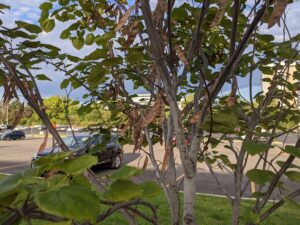
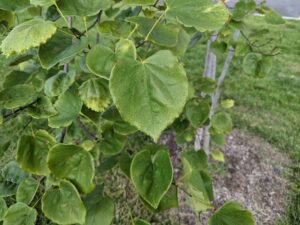
Common Name: Eastern Redbud
Scientific Name: Cercis canadensis
Another genus covered in lecture, this tree was instantly recognizable upon seeing its fruit as well. With distinct dry legumes and heart-shaped leaves (smaller & rounder than that of the Catalpa), this tree is a relatively simple one to recognize if you know what you’re looking for. If you didn’t like me approximately 3 months ago, you might mistake your friendly neighborhood redbud as a basswood. Can’t explain that one away, plant blindness is dangerous. The Eastern Redbud has alternately arranged simple leaves, and flowers in early spring with bright pink-purple flowers. None of course were present on this late summer day. this tree was found in a nearly redone parking lot in a green boundary. A fun fact about this tree according to the Bernheim Arboretum is that in addition to the flowers being edible, the young legume fruits are also an edible treat.
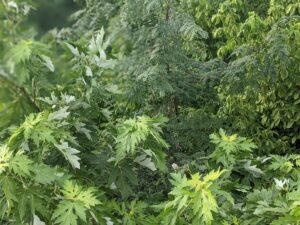
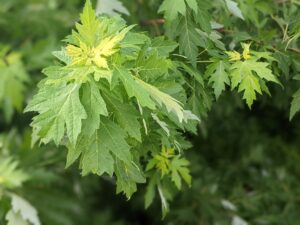
Common Name: Silver Maple
Scientific Name: Acer saccharinum
Another classic tree. While the opposite leaf arrangement and simple lobed leaves are hard to miss, the dead giveaway for this tree (at least compared to closely related Sugar Maples) is the silvery underside of the leaves, which can be seen in the left most picture. While the silver underside was luckily visible from about, another way to differentiate from the Sugar Maple without using leaf shape, is to do a tasting comparison of the saps of both trees. While Silver Maples still have a generally sweet sap, the saccharum variety is significantly more so. This particular tree was found along the Olentangy river’s margins (a meter or two above water) with other saplings and wildflowers abundant around it. An interesting fact found again from the Morton Arboretum is that this plant is incredibly aggressive, being known to invade sewer pipes, though often loses limbs over heavy snow and ice. Not so tough in the cold huh?
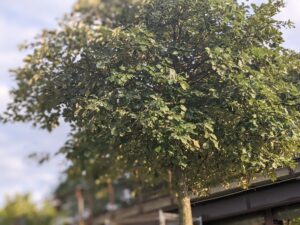
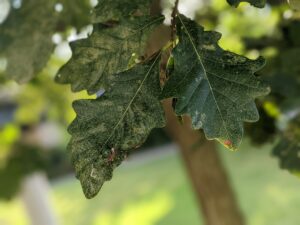
Common Name: White Oak
Scientific Name: Quercus alba
While my recent search history may feature ‘white oak vs swamp white oak’ just about every other day, White Oak is a tree I have some general knowledge on. My main goal with oaks is to just remember the lobing patterns and how that indicates down to a species level. One way that plant blindness manifests in me is that until 2020 I couldn’t have told you what was and wasn’t an oak unless I saw acorns. Which I suppose is better than nothing but learning the bristle tipped difference between Red and White Oaks really blew my mind. The simple leaves on this tree are alternately arranged and lobed, and though the photos do not show it the bottom has a tendency to also be paler than the top, if not white. They should really incorporate that into the name. One notable observation about this tree is that is also experienced a similar blight to the Catalpa and other Oaks nearby along the hill leading towards the Olentangy trail. Besides a general white powdery look on the leaves, the tree seemed otherwise to not be suffering much.
This tree fact is notably a bit sadder than the others but according to the USDA, another disease threatening the Oak genus is Oak wilt. It is a disease caused by the Nitidulid beetle. It is also noted that the disease progression takes longer in White Oaks.

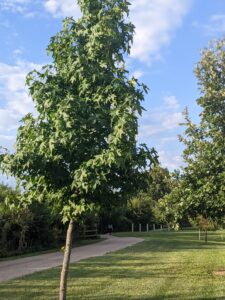
Common Name: Sweetgum
Scientific Name: Liquidambar styraciflua
Another favorite of mine is the Sweetgum tree. I enjoy the general shape of the leaf. I think all leaves should be star or heart shaped, I think it makes for a cool looking tree and the only other acceptable shape is that of the Gingko. This tree was found along the lawn leading up to the Olentangy trail (Pictured Above!). The Ohio DNR also reports that they are commonly found in floodplains, river bottoms, and moist woodland sites. Good, because this section of the trail floods infrequently. This may explain why the tree didn’t appear to have fallen victim to the powdery white found on other nearby trees. Sweetgum trees have alternately arranged simple leaves, with the five lobes and fine serrations giving it that signature star shape. An interesting fact about this tree is that it is a monoecious species that does not flower nor produce fruit for around the first 15 years of itself. Another fact is that I have spent about 10 years cleaning up after the Sweetgum tree in my front yard. Several cars have crashed into that tree and despite a big scar in its trunk, the tree is as healthy as ever. Must be fate at that point.
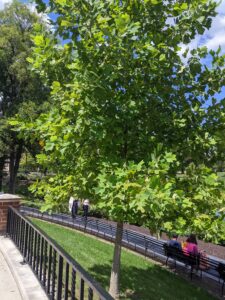
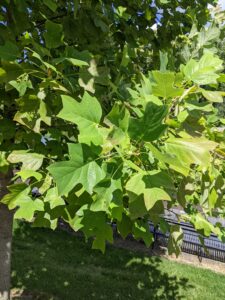
Common Name: Tuliptree
Scientific Name: Liriodendron tulipifera
This Tuliptree was found along Mirror Lake, as you can see in the left most photo. They are within the magnolia family, and are named as their leaves when held upright resemble the cup-like shape of a tulip flower. According to the ODNR, they are the tallest trees within Eastern forest and have the largest solitary flower of all the native Ohio trees. The leaves are distinct and simple with alternate arrangement.
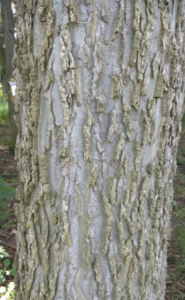

Common Name: Hackberry
Scientific Name: Celtis occidentalis
While no branches were low enough to observe the Hackberry leaves, the good news is that my primary ID characteristic is the bark anyways. The bark of this tree interestingly breaks off in a cork like material. The leaves are serrated, simple, and alternately arranged but the detail that sticks out to me personally is their asymmetry. I spent a lot of time with this tree this summer where leaves were always hundreds of feet up but if you could catch the silhouette as more rounded on one side and the bark flaked off in that corky manner, you had yourself a Hackberry.

